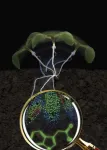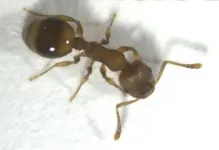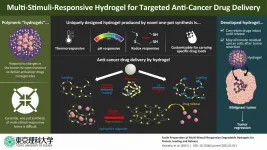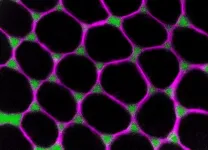New biosensor makes control hormone auxin visible in cells
Scientists at the University of Bayreuth and the Max Planck Institute for Developmental Biology in Tübingen have developed a novel sensor that provides real-time insights into the inner life of plants
2021-04-07
(Press-News.org) The hormone auxin is of central importance for the development of plants. Scientists at the University of Bayreuth and the Max Planck Institute for Developmental Biology in Tübingen have now developed a novel sensor that makes the spatial distribution of auxin in the cells of living plants visible in real time. The sensor opens up completely new insights into the inner workings of plants for researchers. Moreover, the influences of changing environmental conditions on growth can now also be quickly detected. The team presents its research results in the journal Nature.
The effects of the plant hormone auxin were first described scientifically almost 100 years ago. Today we know that auxin controls countless processes in plant cells - be it in the development of the embryo in the seed, the formation of the root system, or the orientation of growth to incident sunlight. In all cases, the hormone has the function of coordinating the plant's responses to external stimuli. To do this, it must always be present in the cell tissue where the response to an external stimulus needs to be triggered. Indeed, it is often the case that auxin is needed at very different places in the cell tissue within a very short space of time. This leads to rapid spatial redistribution. With the new biosensor, called AuxSen for short, the dynamics of these processes can be observed in real time for the first time. Light signals indicate where the auxin is located in the cell tissue. What is special about this sensor is that it is not a technical device that has to be introduced into the plants, but an artificial protein that the plants are engineered to produce themselves.
The application of the biosensor has already led to some surprising findings. One example is the rapid redistribution of auxin when a plant is turned upside down. When the root tip no longer points downwards but diagonally upwards, the auxin molecules responsible for root growth collect on the new underside of the root tip within just one minute. And upon being placed right-side up, the old distribution of auxin is restored after just one minute.
Protein biochemistry and plant biology in combination
The development of the biosensor is the result of many years of interdisciplinary collaboration. A team led by Prof. Dr. Birte Höcker, Professor of Protein Design at the University of Bayreuth, and a team led by Prof. Dr. Gerd Jürgens at the Max Planck Institute for Developmental Biology, have combined their knowledge and many years of experience. "It is to be expected that the new biosensor will uncover many more unforeseen insights into the inner workings of plants and their reaction to external stimuli over the coming years. The development of the sensor has been a long process in which we have gained fundamental insights into how proteins can be selectively altered to bind specific small molecules," says Prof. Dr. Birte Höcker.
"There is already a great deal of interest in the new sensor, and it is to be expected that optimised variants of AuxSen will be developed over the next few years to enable even better analysis of the diverse auxin-regulated processes in plants. With our new publication in Nature, we wish to encourage the scientific community to increase research in this direction. Our results so far are an example of how fruitful interdisciplinary cooperation can be in this field," explains Prof. Dr. Gerd Jürgens from the Max Planck Institute for Developmental Biology in Tübingen.
Advantages of the biosensor: High signal quality and optimal binding strength to auxin
At the beginning of the biosensor's development was a protein in the bacterium E. coli, which binds to the amino acid tryptophan, but much more poorly to the chemically-related auxin. This protein was coupled with two proteins that fluoresce when excited with light of a certain wavelength. If these partner proteins come very close to each other, their fluorescence increases considerably. A fluorescence resonance energy transfer (FRET) then occurs. The next step was crucial: the initial protein was to be genetically modified so that it binds better to auxin and less well to tryptophan. At the same time, the FRET effect of the partner molecules should always occur when the protein binds to auxin, and only then. With this goal in mind, about 2,000 variants of the protein were created and tested until finally a molecule was found that fulfilled all requirements. Thus, the biosensor AuxSen was born: strong fluorescent signals indicating where in the cell tissue the vital hormone is located.
Another challenge was to enable plants to produce AuxSen themselves. On the one hand, it had to be ensured that AuxSen would bind to the existing auxin molecules in as many cells as possible. This was the only way to map the spatial distribution of auxin in the cell completely and to produce high signal quality. On the other hand, however, the auxin molecules were not to be permanently prevented from fulfilling their original tasks in the plant organism because of binding to AuxSen. Nevertheless, the two research teams succeeded in finding a compromise solution. Plants were genetically modified in such a way as to produce a large amount of AuxSen throughout their cell tissue. But this would only happen when stimulated to do so by a special substance - and then only for a short time. In this way, the biosensor provides precise snapshots of auxin distribution in cells without permanently affecting the processes controlled by auxin.
INFORMATION:
[Attachments] See images for this press release:

ELSE PRESS RELEASES FROM THIS DATE:
2021-04-07
Ants react to social isolation in a similar way as do humans and other social mammals. A study by an Israeli-German research team has revealed alterations to the social and hygienic behavior of ants that had been isolated from their group. The research team was particularly surprised by the fact that immune and stress genes were downregulated in the brains of the isolated ants. "This makes the immune system less efficient, a phenomenon that is also apparent in socially isolating humans - notably at present during the COVID-19 crisis," said Professor Susanne Foitzik, who headed up the study at Johannes ...
2021-04-07
Cancer therapy in recent times relies on the use of several drugs derived from biological sources including different bacteria and viruses, among others. However, these bio-based drugs get easily degraded and therefore inactivated on administration into the body. Thus, effective delivery to and release of these drugs at target tumor sites are of paramount importance from the perspective of cancer therapy.
Recently, scientists have discovered unique three-dimensional, water-containing polymers, called hydrogels, as effective drug delivery systems (DDSs). Drugs loaded into these hydrogels remain relatively stable owing to the network-like structure and organic tissue-like consistency of these DDSs. Besides, drug release from hydrogels can ...
2021-04-07
By Karina Ninni | Agência FAPESP – A multidisciplinary research group affiliated with the Department of Physical Education’s Human Movement Laboratory (Movi-Lab) at São Paulo State University (UNESP) in Bauru, Brazil, measured step length synergy while crossing obstacles in patients with Parkinson’s disease and concluded that it was 53% lower than in healthy subjects of the same age and weight. Step length is one of the main variables affected by the disease.
Synergy, defined as combined operation, refers in this case to the capacity of the locomotor (or musculoskeletal) system to adapt movement while crossing an obstacle, combining factors such as speed and foot position, for example. Improving synergy in Parkinson’s patients while they ...
2021-04-07
You might not think an animal made out of stone would have much to worry about in the way of predators, and that's largely what scientists had thought about coral. Although corallivores like parrotfish and pufferfish are well known to biologists, their impact on coral growth and survival was believed to be small compared to factors like heatwaves, ocean acidification and competition from algae.
But researchers at UC Santa Barbara have found that young corals are quite vulnerable to these predators, regardless of whether a colony finds itself alone on the reef or surrounded by others of its kind. The research, led by doctoral student Kai Kopecky, appears in the journal Coral Reefs.
Kopecky and his co-authors ...
2021-04-07
Unusual diseases are medical mysteries that fascinate us, and one such disease is multiple system atrophy, or MSA. This rare neurological disorder causes failures in the proper functioning of the body's autonomic system (processes that are not under our conscious control, such as blood pressure, breathing, and involuntary movement). The resulting symptoms can look like two other types of neurodegenerative disease: Parkinson's disease and cerebellar ataxia. In fact, MSA can be separated into a parkinsonism subtype or a cerebellar subtype based on whether the resultant movement-related ...
2021-04-07
Within multicellular organisms, cells build connections with each other forming cell layers that cover the surfaces of tissues and organs and separate structures in the body. For example, the skin forms a mantle around the entire organism, and the layer of cells lining the blood vessels creates a boundary between the bloodstream and tissues. Special connections between neighbouring cells ensure that these cellular barriers are, on the one hand, stable and tight - thus protecting the body and organs against pathogens - while, on the other hand, they remain permeable to specific substances or migrating cells. This is how the cells allow dissolved ...
2021-04-07
Imagine the process of distributing electricity to homes from the power grid is like travelers boarding a train.
There are multiple steps to take before they can reach their final destination. First, they have to buy a ticket at the ticketing booth - this is where the power is generated. Then, they board a train that departs from the station - the power is transmitted over distances using transmission lines. Finally, the train takes the travelers (electricity) to their final destination. This final step of sending power to homes and businesses is called the distribution system - and it is critical that ...
2021-04-07
Today, the Muon g-2 Collaboration finally published the highly anticipated first result from its measurement of the anomalous magnetic moment of the muon, a precision quantity that offers physicists one of the most promising means to test predictions of the actual Standard Model of particle physics. The measured value, which is more precise than all values before, strengthens evidence for the emergence of new physics beyond the Standard Model, and thus for the existence of previously unknown particles or forces. The result was presented at an online ...
2021-04-07
In a new study, North Carolina State University researchers found that an outdoor science program was linked to higher average science grades and an increase in a measure of science knowledge for a group of fifth grade girls in North Carolina.
The findings, published in the International Journal of Science Education, indicates outdoor education could be a promising tool to help close gender gaps in science.
"The outdoors is a space where teachers can find tangible ways to make science come alive," said the study's lead author Kathryn Stevenson, assistant professor of parks, recreation and tourism management at NC State. "The natural environment is also a place that everybody has in common. In a way, it's also a great context for employing reform-based teaching practices ...
2021-04-07
Conspiracy theories appear to be increasing in popularity as the Covid-19 pandemic continues. But to what extent do people really agree with them, and what is the association with cognitive biases? A research team from the University of Basel studied these questions in German-speaking Switzerland and Germany.
Periods of crisis are often conducive to the emergence and spread of conspiracy theories, and the Covid-19 pandemic is a case in point. A research team led by Sarah Kuhn and Dr. Thea Zander-Schellenberg of the University of Basel has investigated the endorsement rates of coronavirus-related conspiracy theories in German-speaking Switzerland and Germany, ...
LAST 30 PRESS RELEASES:
[Press-News.org] New biosensor makes control hormone auxin visible in cells
Scientists at the University of Bayreuth and the Max Planck Institute for Developmental Biology in Tübingen have developed a novel sensor that provides real-time insights into the inner life of plants






